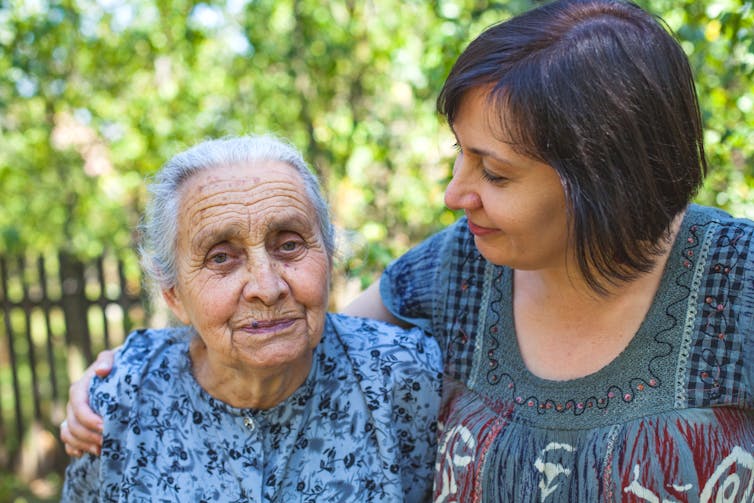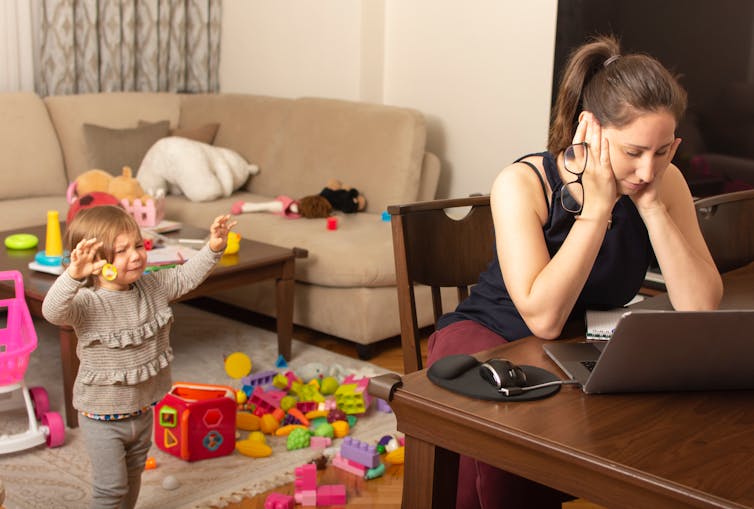
Victoria Atabakhsh, University of Waterloo
At this point, it is obvious that COVID-19 has affected all of us at a personal, societal and global level. Although some normalcy has been restored with the resumption of pre-COVID routines — such as reopening malls and patios — some individuals are still adapting to their new family dynamics and structures at home.
Children are being schooled at home due to the closure of schools, and young adults in college and university have transitioned to online and off-campus learning.
Older adults are particularly vulnerable, and more so if they have pre-existing health issues, and are advised to maintain their physical distancing practices.
Caring for others
Women undertake the vast bulk of caring in the family. The pattern is so universal that it tends to be taken for granted, rather than being recognized as a socially created arrangement. Informal care is currently not valued as labour in the Canadian context and the women caregivers who engage in this field of work, are not recognized for the amount and intensity of work they do.
As a second-year doctoral student in the field of aging, health and well-being, my focus is on intergenerational cohabitation and care partnerships with older adults and their adult daughters. In a time of COVID-19, care partnerships in and outside the home have not only increased, but have come with more responsibility and demand.
Intergenerational cohabitation and sandwich generation caring occurs as a result of aging populations, demographic changes, neoliberal economic policies and economic globalization. Currently, there has been an increase in demand for family care partners.

While men do engage in both formal and informal care work, when it comes to family care, informal care and care in the home, it is typically women who assume the care partner role.
Sandwich generations
Labelled as the “sandwich generation,” middle-aged adult daughters care for both their own children and older parents simultaneously. Statistics Canada reports that in 2018, upwards of 700,000 Canadians were caring for their kids and parents, and the majority of those Canadians are women. Care work can be even more challenging if the older adult parent or child has a disability, disease or illness. As women are still formally employed while sandwiched in between different generation’s needs, stress, anxiety, guilt and tensions have been exacerbated by the pandemic.
As they are made more vulnerable by assuming multiple roles, women also find themselves in situations where moral obligations of care, motherhood, spousal arrangements and formal employment deadlines become unavoidable. Factors that contribute to this vulnerability include culture, financial situations, filial piety (duty to care for one’s parents) and the COVID-19 pandemic.
Even prior to the pandemic, women assumed a number of roles and engaged in a majority of the unpaid work in the home. Women also carry with them a heavy mental load that is expected of them as a mom, from remembering important dates, all family member’s allergies, making doctors’ appointments etc.
Mother, caregiver, teacher
Since schools have closed due to the pandemic, women have added “teacher” to their list of roles. There can be great difficulty with navigating through so many online resources and the added challenge of teaching children lessons that women are not prepared for.
Sharing the same space for doing school, work, play and regular household activities, can be stressful for women as they try to navigate this new lifestyle.

With the number of COVID-19 cases in long-term care homes, adult daughters are transitioning their older adult parents out of long-term care, having their older adult parents move in with them or navigating how to engage in a care partnership at a physical distance.
The ‘third shift’
American sociologist Arlie Hochschild discussed the concept of the “second shift” that women have to take on in the home in their daily lives. With this current pandemic and assuming more care work, new roles, mental work and reproductive labour, all sandwiched in between the needs of different generations, there is now a “third shift” women have to take on.
More than ever, women need support, validation that they are appreciated, to know they have others in their corner and relief from the added labour and stress produced by the pandemic.
Take a moment, check in on the women caregivers in your life and offer your support and aid.![]()
Victoria Atabakhsh, PhD Student in Aging, Health, and Well-Being/RLS, University of Waterloo
This article is republished from The Conversation under a Creative Commons license. Read the original article.

